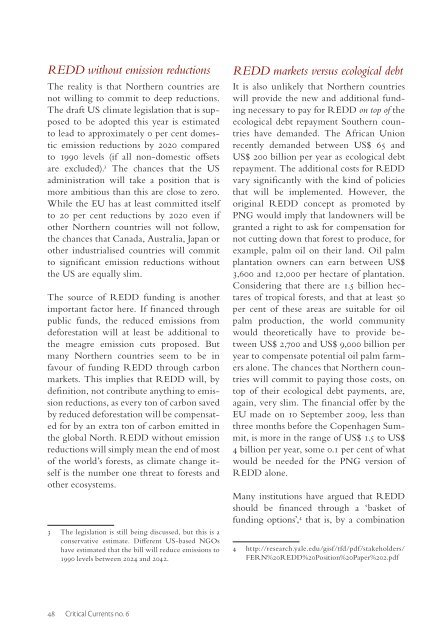Contours of Climate Justice - Dag Hammarskjöld Foundation
Contours of Climate Justice - Dag Hammarskjöld Foundation
Contours of Climate Justice - Dag Hammarskjöld Foundation
You also want an ePaper? Increase the reach of your titles
YUMPU automatically turns print PDFs into web optimized ePapers that Google loves.
REDD without emission reductions<br />
The reality is that Northern countries are<br />
not willing to commit to deep reductions.<br />
The draft US climate legislation that is supposed<br />
to be adopted this year is estimated<br />
to lead to approximately 0 per cent domestic<br />
emission reductions by 2020 compared<br />
to 1990 levels (if all non-domestic <strong>of</strong>f sets<br />
are excluded). 3 The chances that the US<br />
administration will take a position that is<br />
more ambitious than this are close to zero.<br />
While the EU has at least committed itself<br />
to 20 per cent reductions by 2020 even if<br />
other Northern countries will not follow,<br />
the chances that Canada, Australia, Japan or<br />
other industrialised countries will commit<br />
to signifi cant emission reductions without<br />
the US are equally slim.<br />
The source <strong>of</strong> REDD funding is another<br />
important factor here. If fi nanced through<br />
public funds, the reduced emissions from<br />
deforestation will at least be additional to<br />
the meagre emission cuts proposed. But<br />
many Northern countries seem to be in<br />
favour <strong>of</strong> funding REDD through carbon<br />
markets. This implies that REDD will, by<br />
defi nition, not contribute anything to emission<br />
reductions, as every ton <strong>of</strong> carbon saved<br />
by reduced deforestation will be compensated<br />
for by an extra ton <strong>of</strong> carbon emitted in<br />
the global North. REDD without emission<br />
reductions will simply mean the end <strong>of</strong> most<br />
<strong>of</strong> the world’s forests, as climate change itself<br />
is the number one threat to forests and<br />
other ecosystems.<br />
3 The legislation is still being discussed, but this is a<br />
conservative estimate. Diff erent US-based NGOs<br />
have estimated that the bill will reduce emissions to<br />
1990 levels between 2024 and 2042.<br />
48 Critical Currents no. 6<br />
REDD markets versus ecological debt<br />
It is also unlikely that Northern countries<br />
will provide the new and additional funding<br />
necessary to pay for REDD on top <strong>of</strong> the<br />
ecological debt repayment Southern countries<br />
have demanded. The African Union<br />
recently demanded between US$ 65 and<br />
US$ 200 billion per year as ecological debt<br />
repayment. The additional costs for REDD<br />
vary signifi cantly with the kind <strong>of</strong> policies<br />
that will be implemented. However, the<br />
original REDD concept as promoted by<br />
PNG would imply that landowners will be<br />
granted a right to ask for compensation for<br />
not cutting down that forest to produce, for<br />
example, palm oil on their land. Oil palm<br />
plantation owners can earn between US$<br />
3,600 and 12,000 per hectare <strong>of</strong> plantation.<br />
Considering that there are 1.5 billion hectares<br />
<strong>of</strong> tropical forests, and that at least 50<br />
per cent <strong>of</strong> these areas are suitable for oil<br />
palm production, the world community<br />
would theoretically have to provide between<br />
US$ 2,700 and US$ 9,000 billion per<br />
year to compensate potential oil palm farmers<br />
alone. The chances that Northern countries<br />
will commit to paying those costs, on<br />
top <strong>of</strong> their ecological debt payments, are,<br />
again, very slim. The fi nancial <strong>of</strong>f er by the<br />
EU made on 10 September 2009, less than<br />
three months before the Copenhagen Summit,<br />
is more in the range <strong>of</strong> US$ 1.5 to US$<br />
4 billion per year, some 0.1 per cent <strong>of</strong> what<br />
would be needed for the PNG version <strong>of</strong><br />
REDD alone.<br />
Many institutions have argued that REDD<br />
should be fi nanced through a ‘basket <strong>of</strong><br />
funding options’, 4 that is, by a combination<br />
4 http://research.yale.edu/gisf/tfd/pdf/stakeholders/<br />
FERN%20REDD%20Position%20Paper%202.pdf
















